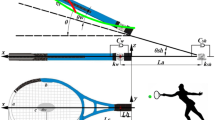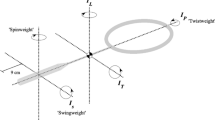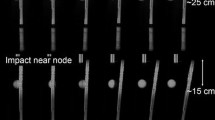Abstract
The ‘feel’ of tennis rackets is of increasing importance to manufacturers seeking product differentiation in a context where further performance enhancements are prevented by a combination of mechanical limits and regulations imposed to protect the integrity of the sport. Vibrations excited during a shot contribute greatly to the perception of ‘feel’. Previous studies have been reported but none has covered the full set of mode families or the frequency range in this study. In-plane vibrations associated with the routine use of topspin shots in modern tennis have not been documented so far in the literature. To consider modal behaviour, multiple measurements during play conditions are required but this is practically impossible. This paper proposes an alternative approach and successfully relates a comprehensive modal analysis on a freely suspended racket to vibration measurements under play conditions. This is achieved through an intermediate stage comprising a necessarily more limited modal analysis on a hand-gripped racket and use of the mass modification modal analysis tool. This stage confirmed the prevailing view that hand-gripping can be considered as a mass modification distributed along the handle of the freely suspended racket but the associated mass was much lower than that of an actual hand and the hand also increased the damping ratio of frame modes significantly. Furthermore, in frame vibration measurements during forehand groundstrokes, a greater reduction in bending mode frequencies was observed, consistent with a mass-loading of around 25 % of the actual hand as a consequence of the tighter grip. In these play tests, the first two bending modes, the first torsional mode, the first eight stringbed modes, the first three hoop modes and the third in-plane bending mode were identified, with the stringbed modes being particularly prominent.











Similar content being viewed by others
References
Brody H (2000) An overview of racket technology. In: Haake SJ, Coe A (eds) Tennis science and technology. Blackwell Sciences Ltd, Cambridge, pp 43–48
Coe A (2000) The balance between technology and tradition. In: Haake SJ, Coe A (eds) Tennis science and technology. Blackwell Sciences Ltd, Cambridge, pp 3–40
ITF (2013) Rules of tennis. http://www.itftennis.com/media/136148/136148.pdf Accessed 12/04/2013
Barrass DF, Roberts JR, Jones R (2006) Assessment of the impact sound in golf putting. J Sports Sci 24(5):443–454
Hocknell A, Jones R, Rothberg SJ (1996) Engineering ‘feel’ in the design of golf clubs. The Engineering of Sport: Proc 1st Int Conf Int Sports Eng, pp 333–337
Roberts JR, Jones R, Rothberg SJ, Mansfield NJ, Meyer C (2006) Influence of sound and vibration from sports impacts on players’ perceptions of equipment quality. Proc IMechE Part L: J Mats Des Apps 220:215–227
Hatze H (1976) Forces and duration of impact, and grip tightness during the tennis stroke. Med Sci Sport Exer 8:88–95
Brody H (1989) Vibration damping of tennis rackets. Int J Sport Biomech 5:451–456
Brody H, Cross R, Lindsey C (2002) The physics and technology of tennis. Racquet Tech Publishing, Solana Beach
Reynolds D, Standlee K, Angevine E (1977) Hand-arm vibration, part III: subjective response characteristics of individuals to hand-induced vibration. J Sound Vib 51:267–282
Miwa T, Yonekawa Y (1979) Evaluation methods for vibrations. Appl Acoust 7:83–101
Hennig EM, Rosenbaum D, Milani TL (1992) Transfer of tennis racket vibrations onto the human forearm. Med Sci Sports Exerc 24:1134–1140
Kawazoe Y, Yoshinari K (2010) Prediction of the impact shock vibrations of the tennis player’s wrist joint: comparison between two super large sized tennis rackets with different frame weight distributions. Dynamics and design conference
Kawazoe Y, Takeda Y, Nakagawa M, Casolo F, Tomosue R, Yoshinari K (2010) Prediction of impact shock vibrations at tennis player’s wrist joint: comparison between conventional weight racket and light weight racket with super large head size. J Syst Des Dyn 4(2):331–347
Stroede CL, Noble L, Walker HS (1999) The effect of tennis racket string vibration dampers on racket handle vibrations and discomfort following impacts. J Sports Scs 17:379–385
Brody (1985) How would a physicist design a tennis racket. Phys today 48(3):26
Barrass DF, Jones R, Dickens P, Hague R, Roberts J (2007) Tennis handle customisation using rapid manufacturing technologies. In: Miller S, Capel-Davies J (eds) Tennis science and technology. Blackwell Sciences Ltd, Cambridge, pp 93–101
Banwell G, Roberts JR, Mohr S, Rothberg SJ (2012) Identifying the modes excited in a tennis racket by a forehand drive Proc. of the SEM: XXX International Modal Analysis Conference
Cutnell JD, Johnson KW (1998) Physics, 4th edn. Wiley, New York, p 466
Vethecan J, Subic A (2002) Vibration attenuation of tennis racquets using tuned vibration absorbers. Sports Eng 5:155–164
Iwatsubo T, Kanemitsu Y, Sakagami S, Yamaguchi T (2000) Development of a racket with an Impact Shock Protection System. In: Haake SJ, Coe A (eds) Tennis science and technology. Blackwell Sciences Ltd, Cambridge, pp 101–108
Korte R, Rossing TD (1990) Modal analysis of tennis rackets. J Acoust Soc Am 88:S20–S20
Timme N, Morrison A (2009) The mode shapes of a tennis racket and the effects of vibration dampers on those mode shapes. J Acoust Soc Am 125:3650–3656
Casolo F, Lorenzi V, Sasahara H (2000) On tennis equipment, impact simulation and stroke precision. In: Haake SJ, Coe A (eds) Tennis science and technology. Blackwell Sciences Ltd, Cambridge, pp 83–91
Gu YD, Li JS (2007) Dynamic simulation of tennis racket and string. Int J Sports Sci Eng 1(1):55–60
Cross RC, Lindsey C (2005) Technical tennis. Racquet tech, California
Kotze J, Mitchell SR, Rothberg SJ (2000) The role of the racket in high-speed tennis serves. Sports Eng 3:67–84
Cross RC (1997) The dead spot of a tennis racket. Am J Phys 65:754–764
http://www.gom.com/metrology-systems/large-scale-cmm.html. Accessed on 02 Oct 2012
Halkon BJ, Rothberg SJ (2003) Vibration measurements using continuous scanning laser Doppler vibrometry: theoretical velocity sensitivity analysis with applications. Meas Sci Technol 143:382–393
Dempster WT, Guaghran GRL (1967) Properties of body segments based on size and weight. Am J Anat 120(1):33–54
Cross R (2010) Impact forces and torques transmitted to the hand by tennis racquets. Sports Technol 3(2):102–111
Author information
Authors and Affiliations
Corresponding author
Rights and permissions
About this article
Cite this article
Banwell, G.H., Roberts, J.R., Halkon, B.J. et al. Understanding the Dynamic Behaviour of a Tennis Racket under Play Conditions. Exp Mech 54, 527–537 (2014). https://doi.org/10.1007/s11340-013-9803-9
Received:
Accepted:
Published:
Issue Date:
DOI: https://doi.org/10.1007/s11340-013-9803-9




